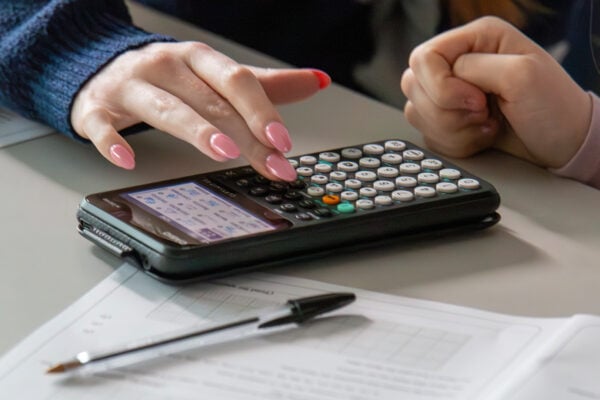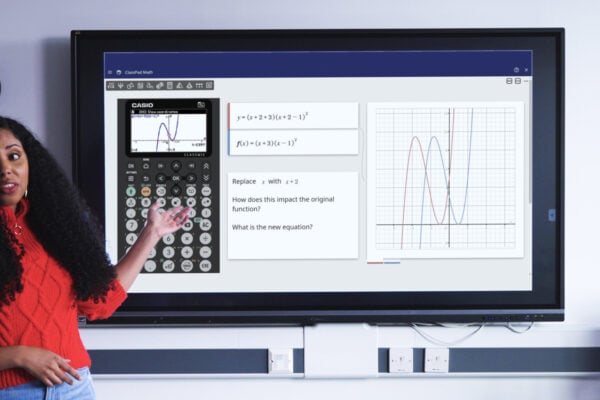A-level maths formula sheet: mastering exams with smart strategies
When the time comes to sit your A-level maths exams, you’ll be given a formula sheet that includes all sorts of useful data you can use when answering the questions in the paper.
In this article, we explore:
- Where you can find A-level maths formula sheets to peruse ahead of your exams
- The various formulae and other useful data you’re given on these sheets
- How these resources can help you in exams
- Other useful things you can do to prepare for your A-level maths assessments

An intro to the A-level maths formula sheet
You’ll be given a formula sheet as part of each paper you sit, but you can also find them in the following places online:
• Pearson Edexcel AS and A-level maths/further maths formulae and statistical tables on Maths Genie
• AQA AS and A-level maths formulae
• OCR A-level maths and further maths formulae booklets
You may find it useful to spend some time looking through these sheets as part of your revision, so you’re clear on what they include and how you will be applying these formulae when answering questions.
Also, you could use the sheet to memorise some or all of the formulae. This might help you feel fully prepared going into exams and also means you won’t have to spend time looking through the sheet to find what you need on examination day.

Formulae to make your life easier in exams
The data included in A-level exam formula booklets can help you tackle questions involving mathematical topics and concepts such as:
• Logarithms and exponentials
• Binomial expansion
• Geometric series
• Trigonometric identities
• Differentiation
• Integration
• Numerical methods, including the trapezium rule and Newton-Raphson iteration
• Standard deviation
• Kinematics
• Probability distributions
This accounts for a significant portion of the content you’re likely to come across in your A-level pure maths, statistics and mechanics exam papers, so it’s a good idea to be highly familiar with these formulae and their relevance to common types of exam questions.

The hidden power of formula sheets: why they might matter more than you think
One of the biggest benefits of having easy access to a range of formulae when revising for and sitting your exams relates to the theory of cognitive load.
This is the idea that human beings only have so much working memory to dedicate to tasks at any one time. In an exam, you should be focusing as much mental energy as possible on activities that will get you marks.
To put this into context, if you’ve already used the sheet to memorise the Newton-Raphson formula, for example, it could free up some cognitive capacity for questions that ask you to apply this method to solve an equation.
Alternatively, if you find it difficult to memorise complicated formulae, you can take reassurance from knowing which ones will always be available for you to check and confirm on the sheet.
Perhaps most importantly, this resource – however you choose to use it – can help you work more efficiently and save time. These should always be top priorities when you only have two hours to complete a 100-mark paper.

Smart ways to use formula sheets for revision
As well as serving as a reference point in exams, the A-level maths formula sheet can be a useful revision tool.
Some steps you can take to ensure it’s beneficial, rather than a source of any unnecessary stress or confusion, include:
• Familiarising yourself with the sheet early on in your revision, so nothing comes as a surprise in the exam hall
• Using it regularly as a practice tool, especially when working through past papers and under timed conditions
• Working with your teacher to ensure you understand the formulae, how to use them and in what scenarios
• Highlighting the formulae you find particularly useful and rely on the most when faced with certain types of questions
• Creating your own personal copy of the formula sheet with additional notes and pointers on putting the formulae into practice

How tech can help you up your A-level maths game
Combining the fundamental formulae, theorems and algebraic methods of A-level maths with advanced technology approved by examination boards is a powerful strategy to do well in your exams.
Our recommendation is for A-level students to use a graphic calculator throughout the full two years of the course. This gives you the time to build confidence with your device and ensure you can use it effectively under examination conditions.
Specific applications and benefits of a graphing handset in your exams include:
• Solving equations both numerically and graphically
• Calculating and visualising probability distributions, including right-hand binomial distributions
• Performing differentiation and integration calculations
• Generating tables of values
• Calculating and graphing sequences

The formula for success in A-level maths
During your revision period, you can also take advantage of the many tools and resources available online. The Bicen Maths YouTube channel, for example, features thousands of videos and guides from maths teacher Seb Bicen, covering topics such as:
• Calculator tips and tricks for A-level maths
• Differentiation explained
• Statistical distributions
• Hypothesis testing
As we’re sure you’ve heard many times from your teacher, success in A-level maths in large part comes down to practice and preparation.
We’re here to help with that in any way we can, which includes hosting dedicated online revision webinars specifically for students.
You can find all the details on this page and reserve a place for the following events leading up to the 2025 exams:
Further maths student revision webinar (May 6th)
A-level (pure) student revision webinar (May 29th)
A-level (applied) student revision webinar (June 16th)
We look forward to seeing you at some or all of these webinars, and best of luck with your revision and exams!
Blog
- Graphing technology
- Scientific calculators
- Exams
- Curriculum
- Classroom
- Students




















